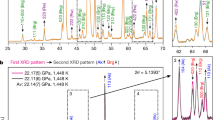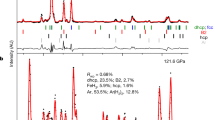Abstract
The Earth’s mantle is characterized by a sharp seismic discontinuity at a depth of 660 km that can provide insights into deep mantle processes. The discontinuity occurs over only 2 km—or a pressure difference of 0.1 GPa—and is thought to result from the post-spinel transition, that is, the decomposition of the mineral ringwoodite to bridgmanite plus ferropericlase. Existing high-pressure, high-temperature experiments have lacked the pressure control required to test whether such sharpness is the result of isochemical phase relations or chemically distinct upper and lower mantle domains. Here, we obtain the isothermal pressure interval of the Mg–Fe binary post-spinel transition by applying advanced multi-anvil techniques with in situ X-ray diffraction with the help of Mg–Fe partition experiments. It is demonstrated that the interval at mantle compositions and temperatures is only 0.01 GPa, corresponding to 250 m. This interval is indistinguishable from zero at seismic frequencies. These results can explain the discontinuity sharpness and provide new support for whole-mantle convection in a chemically homogeneous mantle. The present work suggests that distribution of adiabatic vertical flows between the upper and lower mantles can be mapped on the basis of discontinuity sharpness.
This is a preview of subscription content, access via your institution
Access options
Access Nature and 54 other Nature Portfolio journals
Get Nature+, our best-value online-access subscription
$29.99 / 30 days
cancel any time
Subscribe to this journal
Receive 12 print issues and online access
$259.00 per year
only $21.58 per issue
Buy this article
- Purchase on Springer Link
- Instant access to full article PDF
Prices may be subject to local taxes which are calculated during checkout



Similar content being viewed by others
Data availability
Details of the cell assembly used, representative X-ray diffraction patterns, a backscattered electron image of Mg2SiO4 recovered sample, parameters for the thermodynamic calculations and supplementary discussion of thermodynamic calculations regarding the effects of secondary components can be found in the Supplementary Information. Any additional data can be requested by e-mailing the corresponding author.
References
Xu, F., Vidale, J. E. & Earle, P. S. Survey of precursors to Pʹ Pʹ: fine structure of mantle discontinuities. J. Geophys. Res. Solid Earth 108, B12024 (2003).
Ito, E. & Takahashi, E. Postspinel transformations in the system Mg2SiO4–Fe2SiO4 and some geophysical implications. J. Geophys. Res. Solid Earth 94, 10637–10646 (1989).
Jackson, I. & Rigden, S. M. in The Earth’s Mantle: Composition, Structure and Evolution (ed. Jackson, I.) 405–460 (Cambridge Univ. Press, 1998).
Irifune, T. et al. Iron partitioning and density changes of pyrolite in Earth’s lower mantle. Science 327, 193–195 (2010).
Hofmann, A. W. Mantle geochemistry: the message from oceanic volcanism. Nature 385, 219–229 (1997).
Schubert, G., Turcotte, D. L. & Olson, P. Mantle Convection in the Earth and Planets (Cambridge Univ. Press, 2001).
Anderson, D. L. Theory of the Earth (Blackwell Scientific, 1989).
Murakami, M., Ohishi, Y., Hirao, N. & Hirose, K. A perovskitic lower mantle inferred from high-pressure, high-temperature sound velocity data. Nature 485, 90–94 (2012).
Nishiyama, N., Irifune, T., Inoue, T., Ando, J. I. & Funakoshi, K. I. Precise determination of phase relations in pyrolite across the 660 km seismic discontinuity by in situ X-ray diffraction and quench experiments. Phys. Earth Planet. 143, 185–199 (2004).
Katsura, T. et al. Post-spinel transition in Mg2SiO4 determined by high P-T in situ X-ray diffractometry. Phys. Earth Planet. 136, 11–24 (2003).
Akaogi, M., Kojitani, H., Matsuzaka, K., Suzuki, T. & Ito, E. in Properties of Earth and Planetary Materials at High Pressure and Temperature Vol. 101 (eds Manghnani, M. H. & Yagi, T.) 373–384 (Am. Geophys. Union, 1998).
Ishii, T. et al. Complete agreement of the post-spinel transition with the 660 km seismic discontinuity. Sci. Rep. 8, 6358 (2018).
Katsura, T. et al. Olivine-wadsleyite transition in the system (Mg,Fe)2SiO4. J. Geophys. Res. Solid Earth 109, B02209 (2004).
Fei, Y., Wang, Y. & Finger, L. W. Maximum solubility of FeO in (Mg, Fe)SiO3–perovskite as a function of temperature at 26 GPa: Implication for FeO content in the lower mantle. J. Geophys. Res. Solid Earth 101, 11525–11530 (1996).
Nakajima, Y., Frost, D. J. & Rubie, D. C. Ferrous iron partitioning between magnesium silicate perovskite and ferropericlase and the composition of perovskite in the Earth’s lower mantle. J. Geophys. Res. Solid Earth 117, B08201 (2012).
Frost, D. J., Langenhorst, F. & Van Aken, P. A. Fe–Mg partitioning between ringwoodite and magnesiowüstite and the effect of pressure, temperature and oxygen fugacity. Phys. Chem. Miner. 28, 455–470 (2001).
Frost, D. J. Fe2+–Mg partitioning between garnet, magnesiowüstite, and (Mg,Fe)2SiO4 phases of the transition zone. Am. Mineral. 88, 387–397 (2003).
Holzapfel, C., Rubie, D. C., Mackwell, S. & Frost, D. J. Effect of pressure on Fe–Mg interdiffusion in (FexMg1− x)O, ferropericlase. Phys. Earth Planet. 139, 21–34 (2003).
Holzapfel, C., Rubie, D. C., Frost, D. J. & Langenhorst, F. Fe–Mg interdiffusion in (Mg, Fe)SiO3 perovskite and lower mantle reequilibration. Science 309, 1707–1710 (2005).
Stixrude, L. & Lithgow-Bertelloni, C. Thermodynamics of mantle minerals-II. Phase equilibria. Geophys. J. Int. 184, 1180–1213 (2011).
Wood, B. J. Postspinel transformations and the width of the 670 km discontinuity: a comment on “postspinel transformations in the system Mg2SiO4–Fe2SiO4 and some geophysical implications” by E. Ito and E. Takahashi. J. Geophys. Res. Solid Earth 95, 12681–12685 (1990).
Katsura, T., Yoneda, A., Yamazaki, D., Yoshino, T. & Ito, E. Adiabatic temperature profile in the mantle. Phys. Earth Planet. 183, 212–218 (2010).
Fei, Y. et al. Experimentally determined postspinel transformation boundary in Mg2SiO4 using MgO as an internal pressure standard and its geophysical implications. J. Geophys. Res. Solid Earth 109, B02305 (2004).
Tange, Y., Nishihara, Y. & Tsuchiya, T. Unified analyses for P-V-T equation of state of MgO: a solution for pressure-scale problems in high P–T experiments. J. Geophys. Res. Solid Earth 114, B03208 (2009).
Stixrude, L. Structure and sharpness of phase transitions and mantle discontinuities. J. Geophys. Res. Solid Earth 102, 14835–14852 (1997).
Verhoogen, J. Phase changes and convection in the Earth’s mantle. Philos. Trans. R. Soc. Lond. A 258, 276–283 (1965).
Christensen, U. R. Dynamic phase boundary topography by latent heat effects. Earth Planet. Sci. Lett. 154, 295–306 (1998).
Richards, P. G. Weakly coupled potentials for high-frequency elastic waves in continuously stratified media. Bull. Seismol. Soc. Am. 64, 1575–1588 (1974).
Nakanishi, I. Reflections of P′ P′ from upper mantle discontinuities beneath the Mid-Atlantic Ridge. Geophys. J. 93, 335–346 (1988).
Xu, Y., McCammon, C. & Poe, B. T. The effect of alumina on the electrical conductivity of silicate perovskite. Science 282, 922–924 (1998).
Katsura, T. et al. A large-volume high-pressure and high-temperature apparatus for in situ X-ray observation, ‘SPEED-Mk. II’. Phys. Earth Planet. 143, 497–506 (2004).
Ishii, T. et al. Generation of pressures over 40 GPa using Kawai-type multi-anvil press with tungsten carbide anvils. Rev. Sci. Instrum. 87, 024501 (2016).
Ishii, T. et al. Pressure generation to 65 GPa in a Kawai-type multi-anvil apparatus with tungsten carbide anvils. High. Press. Res. 37, 507–515 (2017).
Kuroda, K. et al. Determination of the phase boundary between ilmenite and perovskite in MgSiO3 by in situ X-ray diffraction and quench experiments. Phys. Chem. Miner. 27, 523–532 (2000).
Ono, S. et al. In situ observation of ilmenite–perovskite phase transition in MgSiO3 using synchrotron radiation. Geophys. Res. Lett. 28, 835–838 (2001).
Irifune, T. et al. The postspinel phase boundary in Mg2SiO4 determined by in situ X-ray diffraction. Science 279, 1698–1700 (1998).
Shimojuku, A. et al. Growth of ringwoodite reaction rims from MgSiO3 perovskite and periclase at 22.5 GPa and 1,800 °C. Phys. Chem. Miner. 41, 555–567 (2014).
Ishii, T., Kojitani, H. & Akaogi, M. Post-spinel transitions in pyrolite and Mg2SiO4 and akimotoite–perovskite transition in MgSiO3: precise comparison by high-pressure high-temperature experiments with multi-sample cell technique. Earth Planet. Sci. Lett. 309, 185–197 (2011).
Ito, E. & Yamada, H. in High-Pressure Research in Geophysics Vol. 12 (eds. Akimoto, S. & Manghnani, M. H.) 405–419 (Center for Academic Publishing Japan, 1982).
Schubert, G., Turcotte, D. L. & Olson, P. Mantle Convection in the Earth and Planets (Cambridge Univ. Press, 2001).
Bina, C. R. A note on latent heat release from disequilibrium phase transformations and deep seismogenesis. Earth Planets Space 50, 1029–1034 (1998).
Kojitani, H., Inoue, T. & Akaogi, M. Precise measurements of enthalpy of postspinel transition in Mg2SiO4 and application to the phase boundary calculation. J. Geophys. Res. Solid Earth 121, 729–742 (2016).
Acknowledgements
We appreciate H. Fischer, S. Übelhack, R. Njul, H. Schulze, U. Trenz and S. Linhardt at Bayerisches Geoinstitut for their technical assistance. We acknowledge N. Tomioka, A. Shatskiy, G. Manthilake, S.-M. Zhai, K. Saito, K. Kawabe, E. Ito, A. Kubo, S. Okita, T. Okishio, M. Sugita, M. Matsui, A. Kuwata, M.-S. Song and S. Yokoshi for their participation in the early stage of this study (2003–2004). This work was supported by the research project approved by DFG (KA 3434/7-1, KA3434/8-1, KA3434/9-1) and BMBF (05K16WC2) to T. Katsura and DFG (IS 350/1-1) to T.I. This project has been also supported by the European Research Council (ERC) under the European Union’s Horizon 2020 research and innovation programme (proposal no. 787 527). T.I. has been supported by a research fellowship for scientific research from the Japan Society for the Promotion of Science (JSPS) for Young Scientists, an overseas research fellowship from the Scientific Research of the JSPS for Young Scientists and an Alexander von Humboldt Postdoctoral Fellowship. The synchrotron X-ray diffraction experiments were performed in the beamline BL04B1 at SPring-8 with the approval of the Japan Synchrotron Radiation Research Institute (JASRI) (proposal no. 2003A0087, 2003B0638, 2004A0368, 2004B0497, 2015A1359, 2015B1196, 2016A1172, 2016A1274, 2016A1434, 2016B1094, 2017A1150, 2018A1071, 2018B1218).
Author information
Authors and Affiliations
Contributions
T.I. conducted most of the experiments, analysed all the samples and data, conducted thermodynamic analysis in the Mg2SiO4–Fe2SiO4 system and wrote the manuscript. T.Katsura directed this project. R.H. and T.Katsura conducted trial runs of preliminary experiments. R.H. and H.F. helped in starting sample preparations. I.K. helped to establish the cell assembly. R.M. conducted thermodynamic calculations to discuss effects of secondary components. F.M., L.Y., Z.L., L.W., D.D., T.Y., S.B., R.F., T.Kawazoe, N.T., E.K., Y.H. and Y.T. operated synchrotron radiation experiments at the beamline BL04B1 at SPring-8. All authors discussed the results and commented on the manuscript.
Corresponding author
Ethics declarations
Competing interests
The authors declare no competing interests.
Additional information
Peer review information Primary handling editor(s): Melissa Plail; Rebecca Neely.
Publisher’s note Springer Nature remains neutral with regard to jurisdictional claims in published maps and institutional affiliations.
Supplementary information
Supplementary information and figures
Supplementary Figs. 1–5.
Rights and permissions
About this article
Cite this article
Ishii, T., Huang, R., Myhill, R. et al. Sharp 660-km discontinuity controlled by extremely narrow binary post-spinel transition. Nat. Geosci. 12, 869–872 (2019). https://doi.org/10.1038/s41561-019-0452-1
Received:
Accepted:
Published:
Issue Date:
DOI: https://doi.org/10.1038/s41561-019-0452-1
This article is cited by
-
Temperature dependence of nitrogen solubility in bridgmanite and evolution of nitrogen storage capacity in the lower mantle
Scientific Reports (2023)
-
Buoyancy of slabs and plumes enhanced by curved post-garnet phase boundary
Nature Geoscience (2023)
-
Post-spinel transition of Fe2SiO4 ahrensite at high pressure and high temperature
Physics and Chemistry of Minerals (2023)
-
Depressed 660-km discontinuity caused by akimotoite–bridgmanite transition
Nature (2022)
-
Segregated oceanic crust trapped at the bottom mantle transition zone revealed from ambient noise interferometry
Nature Communications (2021)



